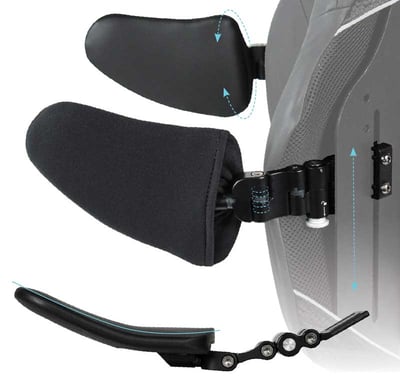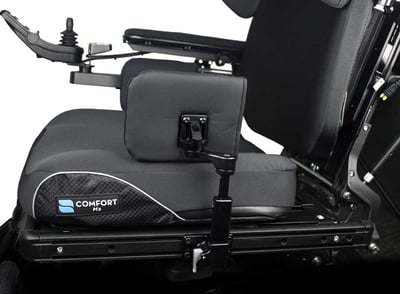We discussed the importance of shear reduction in our recent blog as it relates to pressure injury prevention.
When most people think about pressure injuries or wounds occurring, they often consider what is happening to the pelvic area or sacrum. But pressure injuries, especially those due to shearing, can occur at many other locations on the body.
Wheelchair design has come a long way in ensuring the comfort and mobility of users. In order to achieve these goals, the incorporation of effective shear reduction mechanisms in head supports, trunk laterals, and thigh supports is necessary. Shear forces can cause discomfort and skin breakdown, particularly for individuals who spend extended periods of time in wheelchairs. In this blog, we'll explore the significance of shear reduction in each of these support areas and how advancements in design and technology contribute to a better overall positioning experience.
Head supports
Head supports play a significant role in maintaining proper posture, preventing neck strain, and enhancing overall comfort for wheelchair users. The head’s high risk areas for skin breakdown include the occipital area and ears. Shear reduction in head supports is achieved through thoughtful design and the use of innovative materials. Contoured and adjustable headrests can distribute pressure more evenly, minimizing forces on the neck and head. Memory foam and fabric covers that incorporate materials such as GlideWear™ further contribute to the reduction of friction, ensuring a comfortable and supportive experience for the user.

Trunk laterals
Proper trunk support is essential to maintain stability and help prevent impaired posture such as slouching or leaning to one side. Shear reduction in trunk laterals involves designing supports that conform to the natural curvature of the spine. Additionally, the use of materials with low-friction properties helps minimize shearing forces during movement. Adjustable lateral supports allow for customization, ensuring that each user can achieve support tailored to their unique body shape and needs.

Thigh supports
Thigh supports are integral for maintaining proper leg alignment and assist in preventing discomfort in the pelvic area. Shear reduction in thigh supports is achieved through contoured and cushioned supports that help redistribute pressure more evenly across the thighs, reducing the risk of friction-related issues. Adjustability is key, as it allows users and caregivers to fine-tune the support to accommodate variations in leg length and positioning.

Advancements in shear reduction technology
As technology continues to advance, so does the capability of wheelchair designers to implement cutting-edge solutions for shear reduction. From the use of pressure-mapping technology to assess specific pressure points to the integration of fabric that adapts to the user's movements, these innovations contribute to a more dynamic and responsive wheelchair experience.
Permobil is the exclusive distributor of GlideWear™ shear reduction fabric, an embedded material to the Stretch-Air and Comfort-Tek cover options for Comfort cushions as well as Comfort wheelchair accessories including head supports, lateral trunk supports, and thigh supports! GlideWear™ is lightweight, breathable, and reduces moisture buildup for micro-climate control to protect the skin. By reducing the amount of friction, it reduces the daily stresses on soft tissue and the probability of skin breakdown from the effects of shear.
The role of user education
While technological advancements play a significant role in shear reduction, user education is equally important. Wheelchair users and their caregivers should be informed about the importance of regular body position changes and adjustments as well as proper usage of the supports to maximize shear reduction benefits. Regular maintenance and routine checks ensure that the wheelchair and its components remain in optimal condition, providing long-lasting comfort and support.
Shear reduction in head supports, trunk laterals, and thigh supports is a critical aspect that directly impacts the skin integrity, comfort and well-being of wheelchair users. As the industry continues to evolve, the integration of advanced materials and technologies will further enhance the shear reduction capabilities of wheelchair supports. This contributes to a more inclusive and empowering wheelchair experience for individuals with diverse mobility needs.
Interested in learning more about pressure management and shear reduction? Download our free guide here: Pressure Management Guide here!
 Nicole LaBerge, PT, ATP
Nicole LaBerge, PT, ATPCommercial Product Manager - Permobil Americas
Nicole B. LaBerge, PT, ATP is a Physical Therapist with 17 years of experience in a variety of clinical settings. She currently works for Permobil as a Portfolio Marketing Manager of Seating and Positioning products. Her past clinical practice has included seating and mobility for adult and pediatric populations, with a focus in neurological rehabilitation, power standing and wound care. Nicole has presented at the State and International Levels, has multiple publications in peer reviewed journals and enjoys sharing her passion for patient advocacy, efficiency, and clinical outcomes. She currently serves as an Executive Board Member for the Clinician Task Force.

